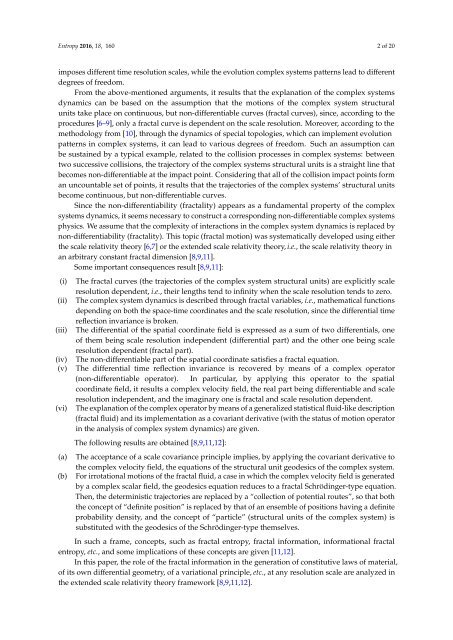entropy-18-00160
You also want an ePaper? Increase the reach of your titles
YUMPU automatically turns print PDFs into web optimized ePapers that Google loves.
Entropy 2016, <strong>18</strong>, 160 2 of 20<br />
imposes different time resolution scales, while the evolution complex systems patterns lead to different<br />
degrees of freedom.<br />
From the above-mentioned arguments, it results that the explanation of the complex systems<br />
dynamics can be based on the assumption that the motions of the complex system structural<br />
units take place on continuous, but non-differentiable curves (fractal curves), since, according to the<br />
procedures [6–9], only a fractal curve is dependent on the scale resolution. Moreover, according to the<br />
methodology from [10], through the dynamics of special topologies, which can implement evolution<br />
patterns in complex systems, it can lead to various degrees of freedom. Such an assumption can<br />
be sustained by a typical example, related to the collision processes in complex systems: between<br />
two successive collisions, the trajectory of the complex systems structural units is a straight line that<br />
becomes non-differentiable at the impact point. Considering that all of the collision impact points form<br />
an uncountable set of points, it results that the trajectories of the complex systems’ structural units<br />
become continuous, but non-differentiable curves.<br />
Since the non-differentiability (fractality) appears as a fundamental property of the complex<br />
systems dynamics, it seems necessary to construct a corresponding non-differentiable complex systems<br />
physics. We assume that the complexity of interactions in the complex system dynamics is replaced by<br />
non-differentiability (fractality). This topic (fractal motion) was systematically developed using either<br />
the scale relativity theory [6,7] or the extended scale relativity theory, i.e., the scale relativity theory in<br />
an arbitrary constant fractal dimension [8,9,11].<br />
Some important consequences result [8,9,11]:<br />
(i)<br />
(ii)<br />
(iii)<br />
(iv)<br />
(v)<br />
(vi)<br />
(a)<br />
(b)<br />
The fractal curves (the trajectories of the complex system structural units) are explicitly scale<br />
resolution dependent, i.e., their lengths tend to infinity when the scale resolution tends to zero.<br />
The complex system dynamics is described through fractal variables, i.e., mathematical functions<br />
depending on both the space-time coordinates and the scale resolution, since the differential time<br />
reflection invariance is broken.<br />
The differential of the spatial coordinate field is expressed as a sum of two differentials, one<br />
of them being scale resolution independent (differential part) and the other one being scale<br />
resolution dependent (fractal part).<br />
The non-differentiable part of the spatial coordinate satisfies a fractal equation.<br />
The differential time reflection invariance is recovered by means of a complex operator<br />
(non-differentiable operator). In particular, by applying this operator to the spatial<br />
coordinate field, it results a complex velocity field, the real part being differentiable and scale<br />
resolution independent, and the imaginary one is fractal and scale resolution dependent.<br />
The explanation of the complex operator by means of a generalized statistical fluid-like description<br />
(fractal fluid) and its implementation as a covariant derivative (with the status of motion operator<br />
in the analysis of complex system dynamics) are given.<br />
The following results are obtained [8,9,11,12]:<br />
The acceptance of a scale covariance principle implies, by applying the covariant derivative to<br />
the complex velocity field, the equations of the structural unit geodesics of the complex system.<br />
For irrotational motions of the fractal fluid, a case in which the complex velocity field is generated<br />
by a complex scalar field, the geodesics equation reduces to a fractal Schrödinger-type equation.<br />
Then, the deterministic trajectories are replaced by a “collection of potential routes”, so that both<br />
the concept of “definite position” is replaced by that of an ensemble of positions having a definite<br />
probability density, and the concept of “particle” (structural units of the complex system) is<br />
substituted with the geodesics of the Schrödinger-type themselves.<br />
In such a frame, concepts, such as fractal <strong>entropy</strong>, fractal information, informational fractal<br />
<strong>entropy</strong>, etc., and some implications of these concepts are given [11,12].<br />
In this paper, the role of the fractal information in the generation of constitutive laws of material,<br />
of its own differential geometry, of a variational principle, etc., at any resolution scale are analyzed in<br />
the extended scale relativity theory framework [8,9,11,12].



